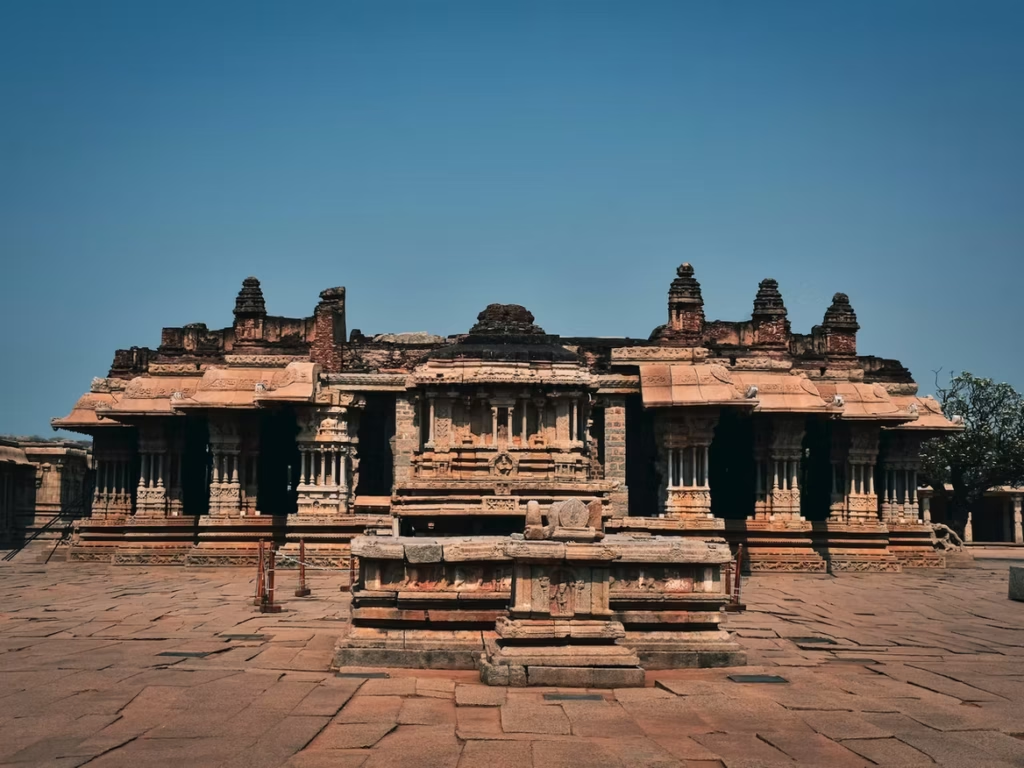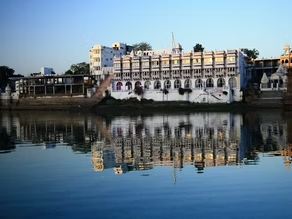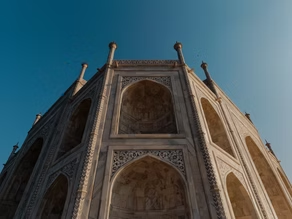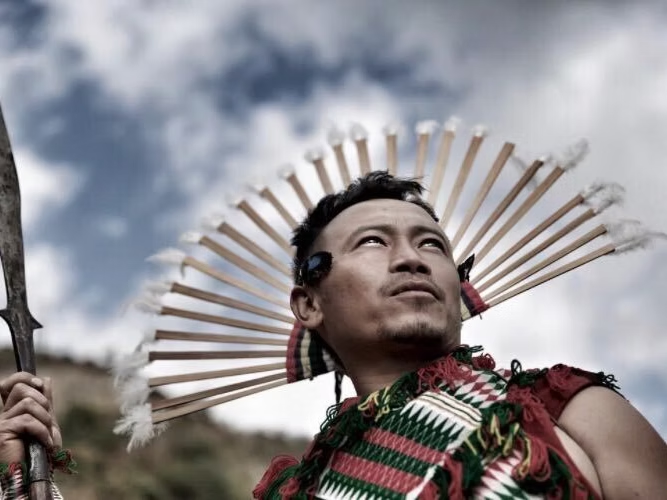9 Ancient Ruins to Visit in India for a Digital Detox

Spend some time at the old-world charm structures that recite all the forgotten stories of ancient history to retain the marvel art of Indian Engineering and architecture. Get ready with a backpack loading all your favorite food, books, and sound bars to spend some time on nature’s lap. A getaway to seclude yourself or plan some group picnics at these calm and quiet places for a digital detox. Do plan a day out to the ancient Ruins near your city: 1. Raigad, Maharashtra. 2. Martanda, Sun Temple, J&K. 3. Hampi, Karnataka. 4. Dhanush Kodi, Rameshwaram. India.com 5. Chapora Fort, Goa. 6. Bhagat Fort, Rajasthan. 7. Rosary Church, Karnataka. 8. Vasai Fort, Maharashtra. 9. Ellora Caves, Maharashtra. Raigad, Maharashtra: A picture from a Wikipedia page. Raigad fort is nestled on the hilltop of Mahad and is also known as the ‘Gibraltar of the East across the world. This fort is the capital of the Maratha empire with the imprints of Shivaji Maharaj and his followers. One can take the ropeway to reach the fort top in 4 minutes or can try an Airtramp to reach the top. Best Time to Visit: September- February. Things to Do: Trekking, and Ziplining. Timings: 8 am to 6:00 pm Entry Fees: 25 Rs per person (Indians) 300 Rs per person (foreigners) 25 Rs per camera video photography Note: Guide services at the ticket counter Martand, sun temple, Jammu and Kashmir: A picture from a Wikipedia page. The sun temple is the offering made by Lalit Aditya to the ancestors of the Sun Dynasty The ruins of the huge temple stand in a square field with snow-capped mountains as its backdrop. The architecture of this sun temple has been built with the integration of Kashmir and Greek skills. Best Time to Visit: September- February. Things to Do: Trekking, and Camping. Timings: 11 am to 7:30 pm Entry Fees: Free Maluti temple, Jharkhand: A picture from a Wikipedia page. The Maluti temple complex is in the tiny Maluti village of Jharkhand. This temple in Dumka is made of terracotta works with great designs and clay works for sculptures. This temple stands out among many ancient structures for its sustainable designs, cultural mix, and Prevailing conservation. The premises has 72 temples of varied deities like Vishnu, Khali, and Shiva. The temple has historical importance among the locals as the primary shrine is dedicated to Goddess Mauliksha. Best Time to Visit: November- March. Things to Do: Temples tour and Explore Village. Timings: 9 am to 5:30 pm Entry Fees: Free Explore the Pristine villages of the Northeast. Hampi, Karnataka: A picture from un splash- Sandip A temple was constructed in14-16 AD and is most renowned by the locals. The12 feet height of Mandapas portrays and resonates with the eternal wisdom of Ancient Indians. Beautiful sounds can be made by our hands, and vibrations are used to represent notes for musical Instruments. Harmonically communicate with God by creating frequencies. Best Time to Visit: September- February. Things to Do: Trekking, and Ziplining. Timings: 9 am to 5:30 pm Entry Fees: 10 Rs per person (Indians) 250 Rs per person (foreigners) 25 Rs per camera video photography Note: Guide services at the ticket counter Dhanush Kodi, Rameswaram: A picture from the Wikipedia website. The temple stands as a shred of historical evidence for Ramayana stories. Dhanush Kodi means ‘end of the bow’, is a temple ruin of Rama devasted during a cyclone. Dhanush Kodi is on the confluence of the Bay of Bengal and the Indian Ocean bridging India and Sri Lanka. Best Time to Visit: October- February. Things to Do: Boating and long drive. Timings: 6:00 am to 6:30 pm Entry Fees: Free Chapora Fort, Goa: Chapora fort is visited by many tourists en route to Baga Beach. This fort is modified by the Portuguese residing in Goa for trading to protect themselves against Maratha attacks. The fort in North Goa is known as Dil Chahta Hai” Fort after its cult status in the movie and attracted all the friend groups to expedite on such trips. Best Time to Visit: July – March. Things to Do: Trekking and Sunrise viewpoint. Timings: 8:00 am to 5:00 pm Entry Fees: Free Bhagat Fort, Alwar, Rajasthan: A picture from the India.com website. The Bhagat Fort is a ruin with many haunted stories and cliche incidents tagged to it, hence it is unknown by many. Tourists must visit the Fort during allowed timings, entry is strictly prohibited after dusk to avoid the unforeseen. Best Time to Visit: July- Mid-March. Things to Do: Trekking. Timings: 8 am to 5:00 pm Entry Fees: No fee Get to know the rulers of Rajasthan and their sovereignty. Rosary Church, Hassan, Karnataka: A picture from un splash – Amit The Shettihalli Church in Hassan entices tourists to revisit the structure as it showcases varied frames in different seasons. It is known as a Floating Church as in Monsoons only the spires and top arches are visible above the backwaters. Visitors can take a coracle ride to the area during this season. In summer and winter, the church turns out to be an island covered with backwaters and hosts tourists for picnics. Best Time to Visit: July – October. Things to Do: Boating. Timings: 6:00 am to 7:00 pm Entry Fees: No Fees Vasai Fort, Mumbai, Maharashtra: A picture from the Wikipedia page. The Vasai fort in suburbs is at the confluence of the Ulhas River and most visited getaway for Mumbaikars. Like many ruins in India, this fort is also an ancient Portuguese trade hub later captured by Britishers and now abandoned. This fort is featured in many shows and is known as a favorite shooting sport for Bollywood. It is not recommended for solo trips and
Top Places to visit in Hampi: Where Travel Meets History & Serenity!

I say this because the place I am telling you about today justifies being a person’s fantasy. Now when a trip is planned we list down a criterion. Okay let’s just do it here; • Unique. • Lots of attractions and activities. • Pleasant weather. • Good food. • Water bodies and Mountains both. (this would be a cherry on the cake) • Best sunrises/sunsets. • Budget-friendly. The place we are literally going to visit with this blog ticks off every point on this list and rises beautifully. Here are the must-visit places in Hampi at the Hippie Island and Central Hampi: Anjaneya Hills, Hippie Island Explore the village of Anegundi, Hippie Island Sunset at sunset hill point, Hippie Island Cafes at the Hippie Island Virupaksha Temple, Central Hampi Mathanga Hill, Central Hampi Vitthala Temple, Central Hampi Ugra Narsimha, Badavi Linga and Krishna Temple, Central Hampi The Royal Centre, Central Hampi Hemakuta Hill, Central Hampi A small town in the south Indian state of Karnataka and is located in the city of Vijayanagara. A UNESCO World Heritage Site: HAMPI. This place is considered a keeper of ancient sculptures, monumental ruins, scenery, architecturally beautiful temples, and visually satisfying sunrises and sunsets. Hampi is situated along the banks of river Tungabhadra and is steeped below 1,400 years of history. It was the capital of the Vijayanagara Dynasty. Chronicles say that Hampi was a prosperous, wealthy, and grand city. Almost all the monuments are from 1336 and 1570 CE. Hampi was destroyed by the Muslim sultanates after the Empire was conquered by them in 1565 and since then Hampi is a beauty even in the ruins. How to reach: By air: Hubli Airport is the nearest one to Hampi which is 166km away and has regular flights from Bangalore. Belgaum connects Mumbai, Chennai, Bangalore, and Jabalpur but is 270 km away from Hampi. But Cabs and taxis are easily available outside the airport to reach Hampi. By road: Hampi is well connected with towns and cities that fall in the state of Karnataka by Buses. Besides the local buses, there are tourist buses available as well. Some of the interstate buses run in Goa, Maharashtra, and Andhra Pradesh. When you reach Hospet you can take Auto rickshaws to Hampi. By train: Hospet Junction is the nearest one to Hampi which is 13km away. The trains travel regularly connecting major Indian cities. You can hire a cab or taxi for further travel. Prepare a perfect experience to Hampi using our travel software here Hampi is divided into 2 parts; Hippie Island & Central Hampi: • Hippie Island: Vipapur village/Gadde aka Hippie Island due to its casual and chilled vibes filled with lush greenery, paddy fields, sunset points, and cafes that serve very tasty food. The purpose of visiting this island is to just relax and have fun. • Central Hampi is filled with dotting temples, history, and some ruins of the royal stays that have stunning architecture. These structures have wonderful sculpting carved all over them. South Indian food will make you restless when you come here. Attractions & Activities: Hippie Island How to reach: Once you reach Hampi, you need to take a boat ride and cross the Tungabhadra River which will take only 5-7 minutes. This you will find near the Virupaksha Temple. The charges are around 50 INR. Things to do: 1) Anjaneya Hills Anjaneya Hill is the birthplace of Lord Hanuman. Stories give evidence of this place. You have to climb 600 (approximately) steps to reach the hilltop. You will experience the very popular sunrise view. This is quite popular among the tourists. There is also a temple dedicated to Lord Hanuman on the hill. You will find a lot of monkeys hopping around in this area. There is no entry fee for the temple but you need to pay for the parking. 2) Explore the village of Anegundi This village is nothing less than heaven. The roads are lined up with Banana trees and Coconut trees and the lands are filled with paddy fields. The rearview covers mountains from Hampi. It is covered in between the huge boulders. The road that takes you to Anegundi has Sanapur Lake. The view is just magnificent and feels like you are in a dreamland. You can also go boating at Tungabhadra Dam in the evening. You will have to hire a moped to wander around the village. It will cost you 250 INR/day. Check out our travel experiences to visit the best places in Hampi. 3) Sunset at the sunset hill point This hill point is filled with tourists just to experience the Sunset. You need to climb the rocky hill. It won’t take you long as it is a very easy one. The vibe on this hill is everything. You will see people chanting mantras or some people engrossed in the atmosphere. At times you will find tourists having a musical evening too. 4) Cafes at the Hippie Island Cafes on the island should be visited. The vibes, décor, food, and music make you fall in love with it. • Nargila Café This place serves you the best Tibetian food. It is a restaurant with perfect vibes for a candle light dinner. • Mowgli Hotel A cafe that gives you a true feeling of being a hippie. Amazing food with and a vfm place. • Laughing Buddha A cafe with laidback vibes and a very colorful interior. The place serves you the tastiest food among all the cafes. • Evergreen Hotel The list is quite a big one but these are must-visit ones. These cafes are surely going to enhance your experience. Central Hampi How to reach: To explore this side of Hampi you have to hire an auto-rickshaw for the internal transportation. You can also choose for a bus but it will
6 Must-Visit Places Near Udaipur That Would Feed Your History Bug!

“WHEREVER YOU GO BECOMES A PART OF YOU SOMEHOW.” – ANITA DESAI The above quote truly captures what travel is all about. Travel changes you. The change may not be massive but the experience you gain surely leaves a subtle impact on your being. Well, we have compiled a list of 6 interesting and fascinating places you must visit if you are in Udaipur. These sites are abundant in historical as well as cultural heritage and would leave an indelible impression on your mind. They would not only captivate your soul but would also provide you with an enriching experience. Since these places haven’t been traveled to often, you might also get to see a pollution-free environment where locals and nature coexist peacefully. Moreover, these places are perfect to fill your Instagram feed with unique yet mesmerizing as well as aesthetically pleasing pictures. 1. Kumbhalgarh The Majestic Kumbhalgarh Fort Kumbhalgarh is a small fortress town on the Aravalli hills, in the Rajsamand district of Rajasthan. It is well known for its beautiful temples and majestic forts. As the description suggests, the highlight of this town is a fort – the Kumbhalgarh Fort. Named after Kumbhakarna, popularly known as Maharana Kumbha, the fort is the second-largest in India and is a UNESCO World Heritage site. The fort which was once said to be impregnable also holds sentimental value because it is the birthplace of the great ruler of Mewar, Maharana Pratap. Moreover, if these facts were not enough to entice you, the Kumbhal fort is surrounded by a 36 km long wall, making it the second-longest wall in the world after the Great Wall of China. The fort still exudes a mesmerizing charm and its beauty and grandeur would leave you awestruck. Distance and How to get to Kumbhalgarh Kumbhalgarh is located at a distance of 86 km from Udaipur. The best way to reach here is by hiring a cab, The journey takes about 2 hours. Things to do & Places to visit Seek blessings at one of the many temples that lie within the boundaries of the Kumbhal fort. The most important temples include Vedi temple, Ganesh temple, Neelkanth Mahadev temple, and other smaller shrines. Don’t miss out on the famous Badal Mahal. Situated at the highest point of the fort, the palace boasts of lovely wall paintings and offers a magnificent view of the surroundings. Visit the Kumbhalgarh Wildlife Sanctuary. The sanctuary is home to a wide variety of fauna which includes the Indian wolf, hyena, jackal, chinkara, and Indian hare. If you visit Kumbhalgarh in the first week of December then you would be able to witness the amazing and breathtaking Kumbhalgarh festival. This 3-day festival, organized by the Rajasthan Tourism Department, pays homage to Rana Kumbha’s contribution to art and architecture. Ideal Time to Visit The best period to visit Kumbhalgarh is during the winter season i.e. from September to March. To know more about this small town check out Subhadip Mukherjee’s informative blog. 2. Chittorgarh The Awe-Inspiring Chittorgarh Fort Chittorgarh, a fortified town located in Rajasthan was once the capital of the Sisodia Rajput Dynasty of Mewar. Cradled in the lap of the Aravalli hills, Chittorgarh echoes with tales that are a testament to the valor and indomitable spirit of the Rajputs. Furthermore, the various forts, temples, and palaces accurately depict the magnificence and splendor of this beautiful city. Chittorgarh is also associated with the mystic saint-poet Mirabai, an ardent devotee of Lord Krishna. We assure you, this town and its heritage are bound to leave you begging for more. Distance and How to get to Chittorgarh Chittorgarh is located at a distance of 119 km from Udaipur. The best way to reach here is by taking a bus or cab. The journey takes about 2 and a half hours. Things to do & Places to visit Chittorgarh is home to the glorious Chittor Fort, the largest fort in India as well as Asia. Constructed in the 7th century AD, the fort is considered a hallmark for Rajput gallantry. This UNESCO World Heritage site is filled with stories of truly exceptional men and women. Do visit the popular Vijay Stambh (Tower of Victory) and Kriti Stambh (Tower of Fame). The former was built by Maharana Kumbha in honor of his victory over Mahmud Shah Khalji while the latter was built to commemorate the first Jain Tirthankara. A tour of the Chittorgarh fort would be incomplete without visiting Rana Kumbh Palace and Padmini’s palace. Possibly the oldest structure in the fort, Rana Kumbh Palace is the birthplace of Maharana Udai Singh, founder of Udaipur. This is also the palace where Rani Padmini is said to have committed Jauhar ( self-immolation by jumping into a holy fire). According to popular folklore, Padmini’s Palace is the place where Alauddin Khalji got a glimpse of Rani Padmini. It is believed that he was so smitten by her beauty that he decided to destroy Chittorgarh in order to possess her. How can we forget about the marvelous and stunning temples? The Kumbha Shyam Temple is one of the most famous shrines in Chittorgarh. Believed to be the private retreat of Mirabai, the temple is adorned with images of several Hindu gods and goddesses. The Kalika Mata Temple is also quite renowned in the city. Originally built as a shrine dedicated to the Sun god, it was later converted into a temple for goddess Kali. Ideal Time to Visit The best period to visit Chittorgarh is during the winter season i.e. from September to March. Want to know more? Do read Moon Roy’s amazing blog. 3. Haldighati Maharana Pratap Memorial In Haldighati If history is something that interests you, then you must have heard of the Battle of Haldighati. This historic battle was fought in 1576, between the king of Mewar, Maharana Pratap, and the third Mughal emperor, Akbar in a place known as,
A Complete Guide to the City of Mughal Marvels, Agra

Agra, a city in northern Uttar Pradesh has been the aristocratic residence of Mughals for many centuries. It is a city full of historical monuments, heritage, and architectural spectacles. Agra is dotted with square Persian styled gardens and magnificent structural design. Along with Delhi and Jaipur, it forms the golden tourism triangle of India and has been monumental in shaping Indian history. A visit to this majestic city is bound to feel like a roller coaster ride filled with anecdotes and legends of the bygone era, while the awe-striking monuments perfectly portray the glory of the mighty Mughal Empire. Agra is a perfect blend of modern and contemporary, while the beautiful establishments recite the grandeur of the past, the city is fully equipped with luxurious and state-of-the-art services for its visitors. While strolling through the bustling roads of this sumptuous city, you would discover that Agra is a place full of many hidden gems, and is not just confined to the colossal Mughal Architecture which makes it popular across the globe. The City of Agra, located in the Northern part of India How To Reach Agra: If you’re wondering how to reach Agra, don’t worry, we’ve got you covered. It is a highly commercialized city, has an airport which is situated at a distance of about 12.5 km from the main city, and 2 main railway stations as well. It is well connected with all the major cities of Northern India, and luxury trains like Palace on Wheels and Royal Rajasthan also have a stoppage in this city. It is connected to the national capital Delhi via NH2 and with Jaipur via NH11. It also has ample bus stops and is connected to many cities via the bus route. One of the beautiful railway stations of Agra, The Agra Fort Railway Station Must-Visit Destinations : If you are planning to visit the beautiful city of Agra, here are some of the places which should definitely not be skipped on your travel itinerary! 1. The Taj Mahal Agra is best known for the Taj Mahal, one of the most exquisite and bewitching spectacles of the world. No matter how many times you’ve been there, its intricate carvings and intoxicating beauty will always leave you mesmerized. It is one of the Seven Wonders of the World, and rightly so. With gemstones adorning its walls, intricate inlay work ornamenting its gables, and a strikingly symmetrical structure, the Taj is undoubtedly one of the finest edifices of Mughal architecture. This astonishing structure is unquestionably one of the best creations of the Mughal era, and what makes it even more extraordinary is the fact that it looks completely different at various times of the day. During the golden hours of dusk and dawn, it exhibits an elegant light pink shade, a dazzling white during the daytime, and a mesmerizing golden hue in the moonlight. Made entirely out of white marble, the majestic monument is a symbol of eternal love, and the mere sight of it is bound to leave you in poetic awe. The mighty Taj has also been referred to as a ‘teardrop on the cheek of eternity’, and with its intricate details, lustrous marble, and a structure tessellated with countless gems, it truly lives up to this lyrical expression. Even though Taj is undoubtedly one of the most impressive creations in the history of mankind, it is only one of the many memorable experiences that Agra has to offer. There are multiple other places that would take you to a journey of the past and would make you feel astonished and stupefied. Agra was a capital of the Mughal Empire for centuries and carries countless unheard tales and mysterious fables of the past to dwell upon. For more material to read on and understand the magnificent Taj, read Urban Travel Blog’s piece on The Taj Mahal and its beauty. Read SandeepaChetan‘s blog on photography tips for capturing the Taj for some great tips that you can use to take home memorable pictures of your trip to Agra. The mesmerizing Taj Mahal, laced with vivid hues 2. Fatehpur Sikri Located to the west of Agra and displaying excellent craftsmanship and compositional skills, is the stunning city of Fatehpur Sikri. This was one of the first cities to be fortified, and its walls contain numerous tacit and unheard historic secrets, waiting to be unraveled and deduced. There are many different buildings within the complex, each with their own significance. The style of architecture is strongly Islamic, with hints of Gujrati and Rajasthani styles peeking in here and there. The striking red sandstone is what gives this city a fascinating hue during the sunset, and is the primary material used to build this magnificent establishment. The city came to be known as Fatehpur Sikri, the “City of Victory”, after Akbar’s triumphant Gujarat campaign in 1573. This place comprises of a stunning mosque, and three palaces, one for each of his favorite wives – one a Hindu, one a Muslim and one a Christian. The grandeur of this deserted city cannot be explained in mere words, and the rich aura can only be experienced when you set foot in this imperial metropolis. One of the most developed cities of its time, Fatehpur Sikri is a true delight to witness 3. The Tomb Of Salim Chishti The Tomb of Salim Chishti is also termed as one of the most exquisite examples of Mughal architecture in India, built along with the imperial complex at Fatehpur Sikri. It preserves the burial place of the Sufi saint, Salim Chisi, who was worshipped and respected a lot by the people of his era. The main tomb building is encircled by delicate marble screens, and the tomb is located in the center of the main hall, which has a single semi-circular dome. The pedestal is ornamented with mosaics of black and yellow marble carved in
The Forgotten Culture of India

Tribes of India Know more about Indian Culture and Indian Culture food and Indian Culture facts and want to know more about the evolution of Indian culture and the Indian culture food and dress – Continue Reading! Now check for few things to know about Indian Culture!! India had always been known as the land that portrayed cultural and traditional vibrancy through its conventional arts and crafts. It is a country that enjoys a unique diaspora. Geographically, we are adorned by the great heights of Himalayas, to sprawling beaches, and dry terrains. But in the midst of all this, we carefully ignore some of the backbenchers of our population, the people who reside away from the comfort of materialism, and who thrive and build their lives amidst nature, the tribals of India. Here’s a list of six unexplored Tribes of India: 1. Konyak Tribes 2. Khasi Tribes 3. Bhotiya Tribes 4. Siddi Tribes 5. Dropka Tribes 6. Kurumba Tribes Tribes of India map 1. Konyak Tribe Konyak, the last tattooed headhunters Residing in the forest interiors of Nagaland, The Konyaks also known as the warrior tribe are an isolated ethnic group defined culturally by their headhunting practice and elaborate facial tattoos. A plethora of color unfolds when you visit the Naga villages; colorful shawls, jewelry, headgear, bags, and jackets with bright colors and tribal motifs are quite a sight to behold. The Konyaks are hospitable, warm-hearted, fond of merry-making and believe that human heads exuded a mystical force that would bring prosperity and benefit local crops and are considered to be the last tattooed headhunters of India. Shubham mansigha tried to best portray the tribal culture of Nagaland in the Hornbill festival 2. Khasi Tribes The colorful Khasi tribes Know more about Khasi tribe dress and Khasi tribe festival: Over the lofty green mountains, and beneath the juniper-colored canopies breathes the high-spirited society of the Khasi Tribe. Residing, among the clouds, on the Jaintia and the eponymous Khasi Hills of Meghalaya they are one of the earliest settlers of the subcontinent. One of “The Seven Huts’ of Khasi they are distinguished by being the only matrilineal society of India. Living a life filled with music, art, and dance the Khasi people are a colorful tribe. With a fashion of long hats, silver jewelry, and prismatic dresses they are kind and warm-hearted people welcoming tourists from all around the world into their homes, giving them a chance to experience their beautiful traditions and holistic culture. Treesisters very well describes the unique culture of Khasi tribes of India 3. Bhotiya Tribes Bhotiya tribes Speaking the fascinating language of Rongba, this tribe of Shepherds is found in the various States of India, primarily Uttarakhand – which we presume has ideal weather to grow pot. Yes, the most interesting characteristic of the Bhotiya Tribal culture is the ritualistic use of marijuana – not for recreational but religious purposes. Hindu mythology and religious traditions have provided Bhotiyas with an interesting set of rituals. Lord Shiva’s association with Bhang, who uses it to keep the world safe from his anger, is a strong Bhotiya belief. Following Shiva’s example, this tribe offers Bhang at celebrations of Holi and Maha Shivaratri. Check out Nomadic shoes blogs to know more about the unique culture of Uttarakhand 4. Siddi Tribes Siddis, the lost gems of Africa found in India Gujarat, known for its scenic beauty of mountain ranges, coastline beaches, and the Great Rann of Kutch is also home to one of the most unusual tribal communities in India, The Siddhis tribe. The Siddis of Gujarat are considered to be the lost gems of ancient Africa, hidden away in India. They don’t retain much of their African heritage, neither language nor history but are guardians of a rich and unique musical tradition that is truly a hidden jewel of Indian indigenous culture. Tanayesh through his Shoestring travel blog intends to portray unique travel stories 5. Dropka Tribe The floral headdressers, Dropkas Legend has it that the Dropka also known as Bropka were the valiant soldiers of Alexander the Great, who got lost from their company. Tucked away in the Paradise of the Earth, Kashmir and the Land of High Passes, Ladakh, these dwellers form a few thousand head community that boasts having a rich culture and a traditional lifestyle. The artistic and evocative attire along with a subtle hint of simplicity brings out a sensational feeling of awe. A distinctive feature of the Bropka tribe is the importance given of flowers in their culture. Signifying purity and love, they can be seen virtually everywhere; around their homes on their motley headgears. Dropka community in Ladakh is a loving community and welcomes tourists and globetrotters with an open arm to witness their unique and eccentric culture. Check out Theiffyexplorer’s blog to know more about the Dropka Tribal culture 6. Kurumba Tribes Kurumba tribes Kurumba Tribe in the Nilgiri Hills is one of the earliest known inhabitants of the Western ghats. Hunting and collecting forest produce being the two main means of living, the tribe lives very much in tune with Nature. While Kurumba men are hunters, cultivators, and gatherers, Kurumba women are traditionally body tattooists. Music, art, religious traditions, and rituals of the Kurumbas are fascinating but the most enthralling thing is their unusual beliefs in sorcery. Their powers are believed to be so effective that other tribes fear and respect them. Illness and death are deemed Kurumba-cast spells. To know more about these unique communities of the Nilgiris, checkout Makeithappen.co.in

